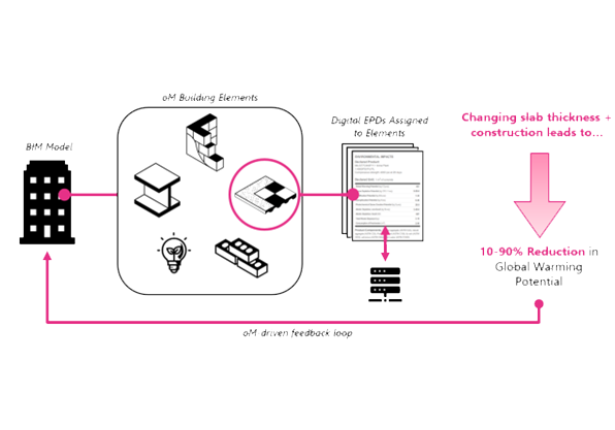Parametric Life Cycle Assessment for Buildings

About this course...
With the built sector’s responsibility for nearly 40% of global carbon emissions, there is pressure and urgency to drastically reduce both the embodied and operational carbon in the buildings that we design as architects and engineers. The study of Life Cycle Assessment has allowed us to understand the whole-life environmental impacts of the materials that we select. However, with myriad design considerations (from climate zone, to building typology, to client requirements) and intricacies (which concrete mix to choose, how to space your structural bays, which glazing system to choose, which refrigerant to choose) comparative benchmarking studies have continually fallen short in explaining the decisions that lead to lower overall whole-life carbon scores.
During this course, we will approach Life Cycle Assessment from an object-oriented, computational perspective by utilizing BHoM Life Cycle Assessment Toolkit. BHoM (Buildings and Habitats open Model) is an open-source platform that is rooted in an object-oriented approach, serving as a common language between software platforms allowing seamless interoperability between building modelling and analysis. We will access this functionality by assessing Revit and Rhino models via both Grasshopper (visual programming) and Excel.
This object-oriented approach allows the physical assessment of building elements (mass, area, volume), a similar break down of the environmental attributes of the element’s material via an Environmental Product Declaration object, as well as the evaluation of Life Cycle Assessment metrics like Global Warming Potential (embodied carbon.)
When our building elements are evaluated through this lens, we are then able to produce pointed delta evaluations by element or scope (structures, foundations, enclosures, interiors or MEP) over a period of time via the BHoM Diffing Engine. This approach when applied to benchmarking allows meaningful comparison of projects by scope (if a project does not include MEP, exclude that scope from comparison in overall kgCO2e/m2 values.)
The approach of Life Cycle Assessment, when paired with structured objects and data can lead to many valuable insights for the building industry. Particularly when applied to problems like identifying forced labor in our building material supply chains or identifying the most harmful materials in our buildings when it comes to the health of the building occupants.
Course Objectives
- Understand the tenets of the study of life cycle assessment: cradle to gate and cradle to grave, environmental metrics, environmental product declarations
- Understand the merits of a data-based, object-oriented approach to the objects that we design
- Study the environmental metrics associated with building elements (walls, floors, light fixtures)
- Achieve meaningful temporal comparison of architectural, structural and MEP elements within a building
- Utilize the Life Cycle Assessment methodology in other important areas: Healthy Materials and Embodied Suffering
>Topics and Tools
| Section | Description | Software Requirements |
| Lecture | Course Overview; Introduction to Life Cycle Assessment | Revit, Rhino, Grasshopper, Excel |
| Lab | Introduction to BHoM | |
| Assignment | Object Creation and Interoperability | |
| Lecture | Environmental Product Declarations + LCA A1-A3 | Revit, Rhino, Grasshopper, Excel |
| Lab | Introduction to BHoM Datasets + EPD Objects | |
| Assignment | Creating and Sourcing EPD Datasets | |
| Lecture | LCA Scopes + Evaluations (Structures, Foundations, Enclosures) | Revit, Rhino, Grasshopper, Excel |
| Lab | BHoM LCA Evaluate Methods + SEI Scopes | |
| Assignment | Group Project 1 – Evaluations of Sample Project SEI | |
| Lecture | LCA Scopes + Evaluations (MEP + Interiors) | Revit, Rhino, Grasshopper, Excel |
| Lab | BHoM LCA Evaluate Methods + MEP/TI Scopes | |
| Assignment | Group Project 1 – Evaluations of Sample Project MEP/TI | |
| Lecture | Design Decision Impacts on Embodied Carbon | Revit, Rhino, Grasshopper, Excel |
| Lab | BHoM Diffing Engine | |
| Assignment | Group Project 1 – Visualizations of Results/Changes | |
| Lecture | Guest Lecture: Benchmarking LCA Results + Policy (Aurora Jensen) | |
| Lab | Present Group Project 1 | |
| Assignment | Identify the industry context around LCA results: policy, tools | |
| Lecture | Existing Benchmarking Strategies | Revit, Rhino, Grasshopper, Excel |
| Lab | Amalgamate Class Results, Create Benchmark Study | |
| Assignment | Interpret the results of the class benchmarking study | |
| Lecture | Operational vs Embodied Carbon | CARE Tool |
| Lab | CARE Tool | |
| Assignment | Design decisions that could have an adverse effect on operational/embodied carbon | |
| Lecture | Guest Lecture: Healthy Materials Introduction (Kathleen Hetrick) | Revit, Rhino, Grasshopper, Excel |
| Lab | Prepping Models for Healthy Materials Evaluations | |
| Assignment | Hypothesis on the validity of applying LCA methodologies in other contexts | |
| Lecture | Healthy Materials Industry Datasets | Revit, Rhino, Grasshopper, Excel |
| Lab | Extend BHoM LCA Toolkit Methodology to Healthy Materials: Datasets, Evaluate Methods | |
| Assignment | Group Project 2: Evaluate Assigned Building Objects for Healthy Materials | |
| Lecture | ||
| Lab | Healthy Materials Group Project Results | |
| Assignment | ||
| Lecture | Embodied Suffering (Identifying Forced Labor in Building Material Supply Chains) | Revit, Rhino, Grasshopper, Excel |
| Lab | Prepping Models/Materials for Embodied Suffering Evaluations | |
| Assignment | Identify recent examples of embodied suffering in the AEC industry | |
| Lecture | Embodied Suffering (Identifying Forced Labor in Building Material Supply Chains) | Revit, Rhino, Grasshopper, Excel |
| Lab | Extend BHoM LCA Toolkit Methodology to Embodied Suffering | |
| Assignment | Group Project 3: Evaluate Assigned Building Objects for Embodied Suffering | |
| Lecture | ||
| Lab | Embodied Suffering Group Project Results | |
| Assignment | ||
| Lecture | Prioritizing the Focus in AEC: Embodied Carbon, Embodied Suffering, Healthy Materials | |
| Lab | ||
| Assignment |

